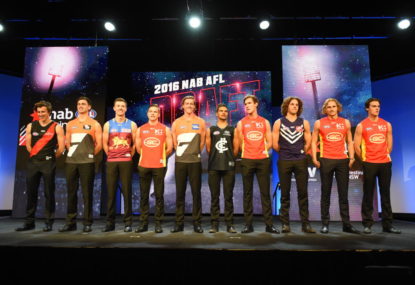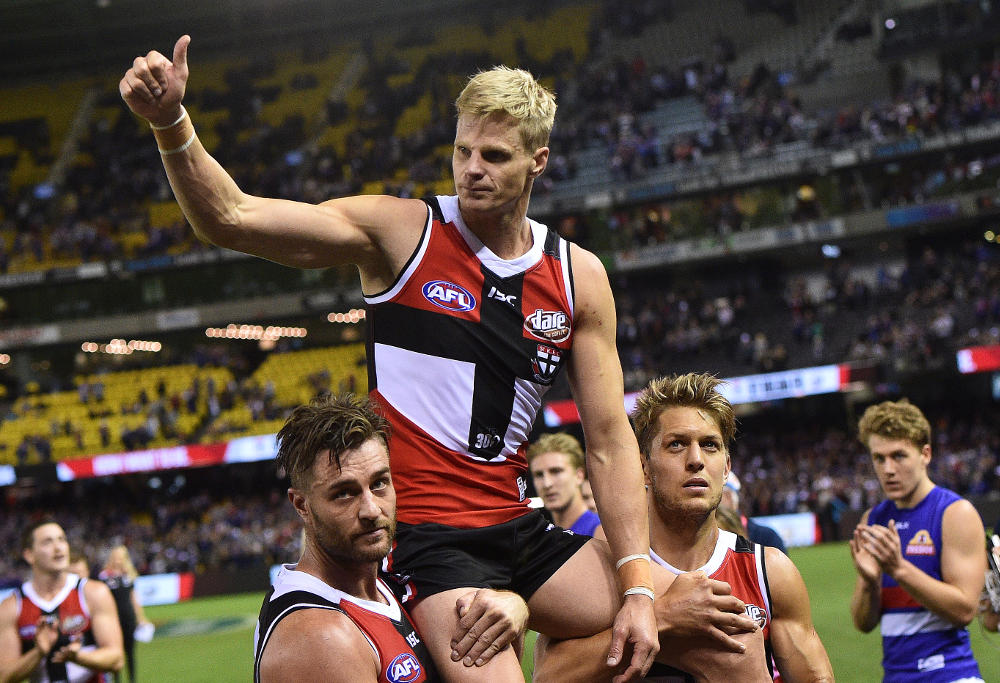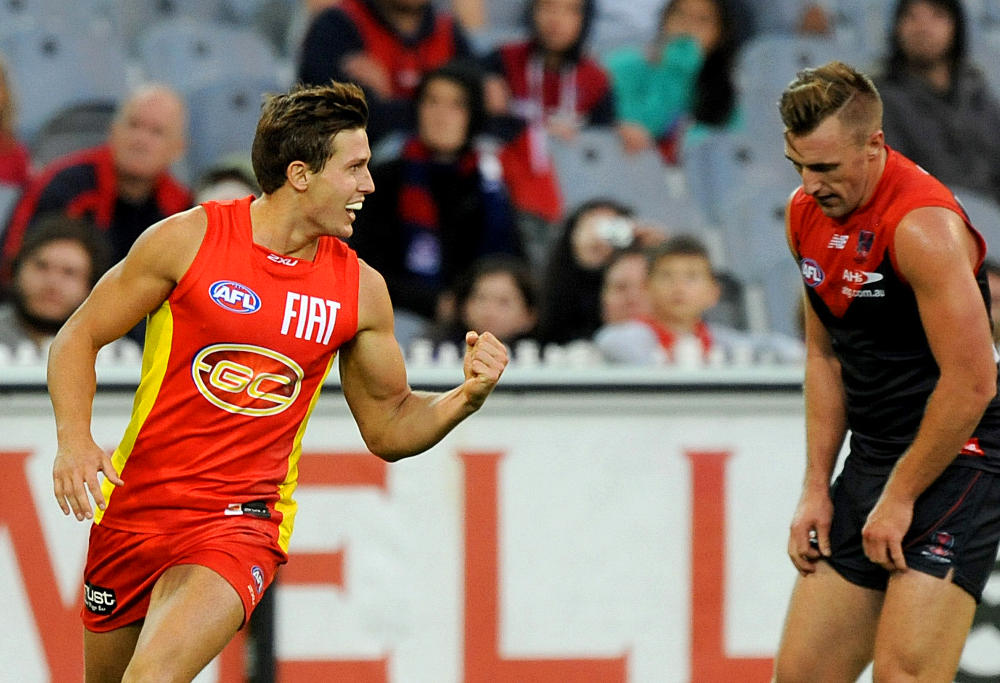Forget Cripps, Curnow and Walsh - the unsung Blues heroes driving Carlton's premiership push
The Blues have truly stood up and are a genuine flag threat in 2024 and they have their younger brigade of troops to thank for it.

With Jack Watts, Bryce Gibbs and Luke Hodge all being traded this year, it struck me, just how good are the number one draft picks?
So, I went back over the history books and analysed just how good the number one picks were.
I went as far back as the 1990 draft. This was the first AFL-era draft so it’s as good as any for starting. I decided to omit the first four years and write them off as the clubs finding their feet in the draft.
What struck me immediately was the number of players that changed clubs. Whether it be through delisting, trading or free agency a total of 15 of 27 draftees, or 55.55% have finished playing at a different club.
Only three clubs – Essendon, Geelong and Gold Coast – have not traded a player taken with the first selection.
Adelaide, Port Adelaide, North Melbourne and, remarkably, Fitzroy never have had the (dis)honour of holding the number one pick, while Hawthorn traded to receive the pick they would use on Luke Hodge.
Carlton have had the most with four (2005, 2006, 2007 and 2015), and until Bryce Gibbs was traded to Adelaide last week, had retained all of them.
On the other hand, Melbourne have had three number ones (1997, 2008 and 2009) and with Jack Watts traded, have lost every one of them. Melbourne is the only club to have lost more than one.
Nick Riewoldt was selected in 2000 and Luke Hodge in 2001. Both are highly decorated and would be considered genuine superstars.
Riewoldt played 336 games in his 17 seasons, was named All Australian five times, played in two grand finals (and a replay), won the Rising Star, the Players Association MVP and six Best and Fairest awards.

(AAP Image/Julian Smith)
Hodge won four premierships from five grand finals and was a three-time All Australian. He also won two Norm Smith medals and Best and Fairest twice. He turned out for the Hawks 305 games over 16 seasons and has now been traded to the Brisbane Lions.
Next are Brendan Goddard in 2002, Adam Cooney in 2003, and Brett Deledio in 2004. All accomplished and decorated, all playing more than 200 games for their clubs.
This group includes a Brownlow Medal, five All Australian caps and a two Best and Fairest medals. All three moved clubs, Cooney and Goddard moving to Essendon, with Goddard becoming the first big-name free agent and Deledio traded to the Giants.
I’d throw Jeff White in 1994 into this category too. Drafted by Fremantle in 1994, he played 32 games in three seasons before requesting a trade to Melbourne as the first number one selection to be traded.
For the Dees, he played 236 games including a grand final and scored All Australian and Best and Fairest caps before being delisted.
Other picks to go west include Drew Banfield for West Coast in 1992, the first one-club player. He managed 265 games with two premierships from three grand finals. He was also the first number one to retire.
In 1995 Fremantle took Clive Waterhouse. Just the second player to remain at the one club, he played 106 games over nine seasons before being delisted.
Michael Gardiner was picked in 1996 for the Eagles and was traded to St Kilda after 129 games, including a grand final, and an All Australian. He added 52 games at St Kilda, including another grand final.
Sydney managed 21 games from Darren Gaspar in 1993 before delisting him after two years. He was picked up by Richmond and added 207 games, a Best and Fairest and two All Australian guernseys to his record. In 1998, Brisbane Lions took Des Headland, who played 52 games including a premiership. He was traded to Fremantle to play out his career with an additional 114 games.
Collingwood took Josh Fraser in 1999 where he managed 200 games, including two grand finals. He was signed by the Gold Coast as an uncontracted player where he played an extra two seasons and 18 games.
Carlton scored three number ones in a row, Marc Murphy opting not to nominate for the Lions as a father-son in 2005, Bryce Gibbs being ineligible for an Adelaide father-son in 2006 and Matthew Kreuzer in 2007. They have played 236, 231 and 161 games respectively, with two All Australian nominations, an additional All Australian squad selection, three Best and Fairest awards and an AFLCA player of the year.
All three remained loyal to their drafted club until the Blues and Crows agreed on a deal for Gibbs this year.
Melbourne’s three selections came in 1997 with Travis Johnstone, Jack Watts in 2008 and Tom Scully in 2009. None of these three remained at Melbourne for their whole careers. Johnstone played in the losing 2000 grand final and won a Best and fairest in 160 games at Melbourne, moving to the Brisbane Lions, where he added 49 games in five seasons.
Scully played 31 games, then signed with GWS as an uncontracted player, has played another 120 games. Watts now at Port Adelaide, played 153 for Melbourne, the most without a finals appearance of any current player.
In 2010 the Gold Coast received the number one pick and they opted for David Swallow. He has played 97 games and earnt a Best and Fairest win. There was talk of a transfer but nothing has eventuated from it. GWS received the first pick in 2011, 2012 and 2013 through allocation and some shrewd trading.

(AAP Image/Joe Castro)
They took Jonothon Patton, Lachie Whitfield and Tom Boyd in each of these years. Boyd spectacularly left the Giants after his first season and nine games to move to a lucrative deal with the Western Bulldogs.
He has since played 40 games including the 2016 premiership. Patton and Whitfield have 77 and 90 games in their short period of time at the Giants.
You could be forgiven for not knowing the first two players on the list. Stephen Hooper was taken by Geelong in 1990 for 21 games in three seasons, while John Hutton played 18 games for the Brisbane Bears, five games for Sydney and 13 games for Fremantle before being delisted at the end of each season.
From the first to the newest members of the number one club: Paddy McCartin in 2014, Jacob Weitering in 2015 and Andrew McGrath last year. It’s still too early to know how their careers will progress.
Overall, I think clubs are getting better at identifying and managing number one picks, although it’s clear that there are only a handful of players that would be considered outright stars.
While there have been few emphatic failures, it seems that the shine of a number one selection can wear off, and with a variety of factors at play, being drafted as a number one is certainly no guarantee of success.
With over half the number one selections finishing their careers at clubs elsewhere, the number one is certainly as readily traded as any other.
Perhaps being number one is not as important as it seems. It could, in fact, be a case of hit and miss.